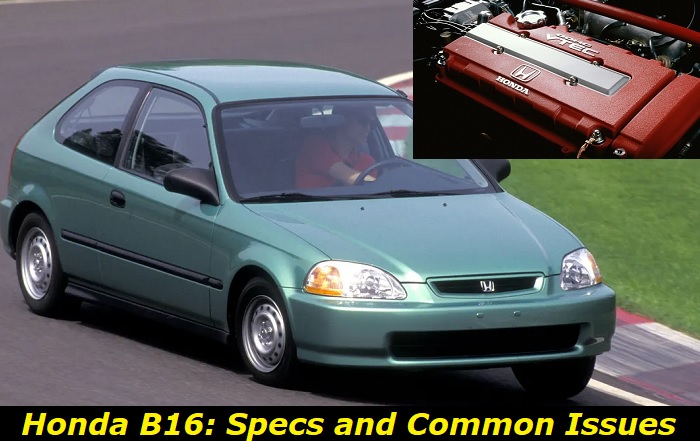The Honda B16 engine was initially introduced to the market around 1989. This engine was so well received that it later gave rise to six generations within 11 years. The original Honda B16 engine came equipped with the legendary VTEC system, made of an aluminum block that is light in weight and an inline-4 set-up.
The Honda B16 engine has a well-deserved rockstar reputation. It is built using quality components and a 9,000-rpm stock. These factors contribute to the B16 engine being one of the most memorable engines ever produced in the Japanese domestic market.

The current popularity of the Honda B16 engine came about after the Honda B16A2 engine was introduced to the market in the 1999 Honda Civic Si. During this time, the B-series, for the first time, sold in the US in Del Sol. One of the factors that contributed to the B-series engine's popularity is that it has a spectacular horsepower-to-liter ratio.
When the first generation of the Honda B-series was designed, it was equipped with 160hp, which translated to 100hp-per-liter. When the other Honda B-series engines started coming up, Honda decided to give the stock engine horsepower of up to 185. The design of the B16B engine was capable of using the redlines and the original VTEC technology.
Using the two technologies together was a good choice for a stock engine, thus making it convenient and reliable. This article will take a good look at the history of this great engine and how to discharge its full potential.
Key features and my opinion about the engine
- Production years:1989-2000
- Average lifespan of B16:230,000-260,000
- Fuel supply type:port injection
- Power range:150-185 hp
- Fuel efficiency:average
- Engine block material:aluminum
- Engine reliability score:high
- The most common problems:head gasket may fail pretty early, it's important to change timing belt on time, no lifters.
Honda B16 Specs and Generations
This part will look at the Honda B16 engines and the specific generations. Below is the list of each engine and its specs.
The First Generation of Honda B16A Engine
The Honda B16A engine was the first generation and came with a practical 100-horse-power-per-liter ratio with a capacity of 1.6L, which translates to1,595cc. The first-generation engine had the following features:
- VTEC engagement system ranging from 5,500rpm
- An 8,000rpm redline
- The compression ratio is about 10.2:1
- A rev-limiter that is up to 8,200rpm
- Peak torque of about 7,000rpm ad also 111lb/ft.
Honda saw fit to modify the engine to suit their newer fleet better and eliminate certain issues that users had complained of.
The Second Generation of Honda B16A Engine
The second generation B16A was similar to but better than the Honda B16A's first generation engine. The second generation's engine had a compression ratio of 10.4:1, and it also came with new pistons that contributed to the change in the compression ratio. The second generation used a small camshaft with a throttle of around 60mm.
Though the engine's VTEC system was still kicking at 5,500rpm, the modifications assisted the second generation greatly in achieving a maximum power of 170hp at 7,800rpm, which in turn raised the redline to 8,200rpm
The Honda B16A1 Engine
This engine is very similar to the B16A, but it was designed for the European market. The engine came with the following;
- Peak horsepower of 150hpat 7,600rpm
- A 111lb/ft torque that was at 7,100rpm
- A compression ratio of about 10.2:1
- A rev limiter of about 8,200rpm
- A VTEC system that kicks in at 5,200rpm
The Honda B16A2 Engine
This Honda B16A2 engine came with different camshafts, but the compression ratio was the same as the B16A1 engine, about 10.2:1. When it comes to power, it comes with a horsepower of about 160 at 7,600rpm. The engine has a total torque of about 111lb/ft at 6,500rpm.
The B16A2 engine variable valve timing and lift electronic control system is used at about 5,600, and it attains the redline at about 8,000 before attaining the limiter at 8,200rpm.
The B16A3 Engine
Del Sol was the main target for this engine, as it was, intended during the design and construction of the engine. The engine comes with a compression ratio of about 10.4:1, and also, the engine provides a horsepower of about 160 at an rpm of about 700. The Honda B16A3 engine has a 111lb/ft torque at6,700rpm. This engine has VTEC activated at an rpm of 5,600 and consequently attains the redline at an rpm of 8,200 and the rev limiter at an rpm of about 8,500.
The Honda B16 A5 Engine
Honda designed the B16A5 engine purposely for the Honda cars that are automatic, which are included in Civic SiR. Honda designed and produced the B16 A5 and made it possible to increase power with a horsepower of about 174hp at 7,800rpm. The manufacturers ensured the torque did not change and remained at 110lb/ft at 6,200rpm, and also the red line and the compression ratio remained constant.
The Honda B16 A6 Engine
Honda designed the B16 A6 engine based on the B16A2 engine, which was made mainly for the South African and Middle East markets. The engine comes with a compression ratio of 10.2:1 and making it possible to achieve 158ho at an rpm of about 7,700 and about 119lb/ft torque at about 6,400. At the same time, the variable valve timing and lift electronic control system are activated at an rpm of 5,500.
The Honda B16 B Engine, Also Known as the Type R Engine
The B16 B engine is highly recommended among all the B-series engines in stock. It is preferred because it was improved since they last revised the B-16 A second-generation engine. Honda chose to de-stroke the engine, creating space for the crankshaft to be upgraded with the pistons and connecting rods that are light and long and provide a ratio of about 1.85:1.
The intake ports were also adjusted, and Honda expanded the body of the throttle up to 61mm. The injectors for injecting fuel were also upgraded, and an enhanced exhaust system was. The engine also came with a light flywheel.
The B16B engine came with upgraded camshafts, intake valves that were lighter than before, thin stems, and stronger valve springs. The enhancements mentioned above led to a compression ratio of about 10.8:1. The horsepower given out is about 185hp, and at other times, it may be 186hp at 8,300rpm and 110lb/ft torque at 7,400rpm.
The Honda B16B engine VTEC system activates at 6,100rpm and with a continued redline at 8,300rpm before attaining a rev limiter at about 8,900rpm.
Typical Problems Associated with Honda B16 Engines and Maintenance
Honda did an excellent job with the B16-series engine in that the engines have very few common issues; this applies to the well-maintained stock engines. Very few owners of a brand-new B16 engine have any mechanical problems if they perform proper maintenance and refrain from ill-advised modifications. The B16 engine will not do you any good whenever you install a giant turbo, as the engine will take a beating whenever you blast it off.
Though the engine is over 30 years old, the VTEC system can hold its own amongst the recently designed systems. Because of the VTEC system's presence, you are recommended to carry out a compression test whenever you want to buy a Honda B16-series engine. The required compression is about 169-189PSI on the warm engine.
Some older Honda B16 engines tend to burn more oil than expected. The B16-series engines that consume more oil result from pushing your car so hard. With all said and done, you should ensure you keep an eye on the oil level and top up when necessary.
It is advisable to change the oil filters as often as possible regularly, and by doing so, you increase the longevity of your engine. The most common fault in the B16 engine issues with the idle, but at the same time, it is a simple repair. Another common problem is with leaking around the camshaft seals.
Conclusion
Generally, the Honda B16-series engine is impressive, especially for its size. Whenever you are looking to tune your engine to attain high power figures, the B16-series engine can give crazy horse-power-to-displacement figures. Though the Honda B18 and B20 engines are suitable for turbo-swaps, the B16 engine comes across as cost-effective and cheaper to buy and maintain.
Don't be stressed when you want more considerable functioning down the line, as it is possible to bore your B16-series engine to 1.7L down the line when required. The B-series engine comes across as more reliable than many other engines.
The B-series engines are aging gracefully as it does not bounce off the redline without having to change your oil. Whenever you are concerned about a condition of a particular engine, you should carry out a compression test that can tell whether you should be concerned or not. With the right use and maintenance, your Honda B16 engine will outlast almost all the other components in your car.
About the authors
The CarAraC research team is composed of seasoned auto mechanics and automotive industry professionals, including individuals with advanced degrees and certifications in their field. Our team members boast prestigious credentials, reflecting their extensive knowledge and skills. These qualifications include: IMI: Institute of the Motor Industry, ASE-Certified Master Automobile Technicians; Coventry University, Graduate of MA in Automotive Journalism; Politecnico di Torino, Italy, MS Automotive Engineering; Ss. Cyril and Methodius University in Skopje, Mechanical University in Skopje; TOC Automotive College; DHA Suffa University, Department of Mechanical Engineering






Add comment